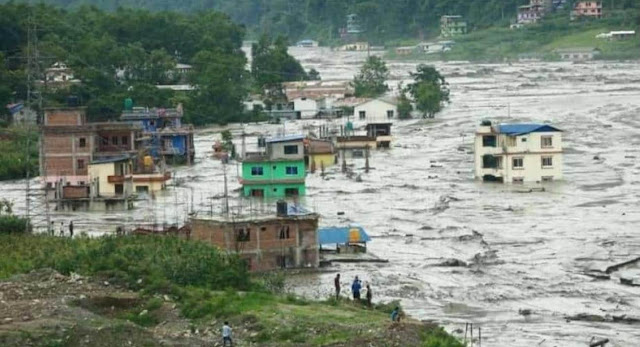COMBATING AGAINST NATURAL DISASTER
Many reports have duly confirmed that Nepal is one of the most disaster-prone countries in the world. However, none of the governments in the past or present has ever taken this warning seriously.
 |
| Landslides and floods are recurring issues. The government must make a thorough master plan to counter such nature's wrath. Photo: The Nepali Times. |
By LB THAPA
Perhaps due to constant abuse of nature to such extent that now we are experiencing the wrath of nature in the form of natural disasters. The increasing rate of deforestation, belching smokes from ever-increasing numbers of vehicles, digging out the length and the breadth of the mountains for making motorable roads, water pollutions, mismanagement of garbage and many more have only aggravated the environment to go bad to worse.
Many reports have duly confirmed that Nepal is one of the most disaster-prone countries in the world. However, none of the governments in the past or present has ever taken this warning seriously. Instead, they have just confined their activities within the periphery of rescue and rehabilitation. They never thought of developing the necessary infrastructure to mitigate the recurring problems one like floods and landslides. As a matter of fact, every year scores of people die due to floods and landslides across the country.
In the danger zone
According to the research, Nepal has been put in fourth place in terms of vulnerability to climate change. It is even so scary to know that over 80% of the people of Nepal are at a high risk of some kind of natural disaster. And every year during the monsoon, many people both from the hilly and Tarai regions lose their lives and property beyond calculation. It is beyond one’s comprehension that when disasters like floods kill so many people and trigger a humanitarian crisis almost every year, why not a serious approach has been taken to find a final solution to the problem. Every year during monsoon time, helicopters will fly and rescue a few stranded people here and there. And army boats will carry some flood victims to a safe place where they are kept under tents until the floodwater subsided. Sometimes, those people who lose their family members in the disaster, get even compensation. This is the way how so far our governments have been tackling natural disasters like floods.
How the situation has already turned dire for Nepal, can be better understood by a report only published last year by NASA. According to this report, about 30 to 70% more landslides will occur along the Nepal and China border regions. As a result those people who live nearby the riversides will have come under direct threat from floods. In addition, the Department of Hydrology and Meteorology has already made forecasts about the warmer and wetter climate in days to come. According to this department, the average annual mean temperature and average annual rainfall will soar regularly in the coming years. This will only add more owes to the people who live beside the rivers and across the hilly region. Moreover, according to a very recent global report, precipitation possibly increases by 11 to 23%, and possibly temperature might hike up by 1.72 to 3.58% degrees Celsius.
Need strong willpower
Over the years it is found that average rainfall has unexpectedly increased in the north-western and north-eastern districts. These intense downpours have been the causes of floods and landslides. According to the National Disaster Risk Reduction Management Authority (NDRRMA), due to the incessant rainfall since June 14 has affected 17 districts of the country. This is just the beginning of the monsoon with such a magnitude of destruction. What we can expect in the days to come is only more loss of lives and property beyond imagination. Can we stop any more loss of lives and property? Of course, why not? It is still possible. A concerted effort must be initiated where the government must come up with strong willpower to tackle the problem.
Now the time has come for our government to take serious steps against incurring floods. With the help of national and international environment and disaster management experts, the government must form an expert team to work for disaster management. Strong policies with proper legal provisions should be made. And those provisions must be implemented without any compromise.
On top of, a proper survey should be made to ascertain regular paths of different rivers. After then no human structures of any kind should be allowed to build nearby the paths of the major rivers. Strong embankments should also be erected wherever the chances of soil erosions and landslides are high.
Throwing a glance at the present disaster, it has been noticed that many human settlements were actually built in close proximity to the river’s path. Thus, looking at the first week of monsoon havoc, it can be said that it was not the river that entered the human settlements. Actually, people had reached too close to the path of the rivers. Thus, no human settlements should be allowed within the close proximity along the path of the river.
Roads in the villages
Nowadays, many villages have begun digging roads to connect their villages with the national highways. We can see this trend across the hilly and mountainous regions of the country. In order to make roads, many trees are being cut and heavy dozers smash mounds and hills, taking out heavy boulders from their places. As a result, the soil in such areas becomes lose and during heavy rainfall, such soil easily falls apart. Thus, such roads in the hilly and the mountainous areas should be made but only after a proper survey conducted by experienced engineers and geologists.
In fact, some people welcome the idea of road construction in the hinterlands, whereas many others hold a different opinion altogether. Such motorable roads have already reached many remote villages. As a result, many foreign trekkers strongly dislike trekking on motorable roads where many vehicles leave behind hazardous smoke for trekkers to inhale. These foreign trekkers don’t like to inhale dirty black smoke belched out by those rickety buses. No one can deny the fact that several popular trekking routes now have turned out to be a busy route where ply several jeeps, vans, motorbikes, and micro-buses. As a result, a large number of foreign trekkers have stopped trekking those destinations, which have been once upon a time noted popular trekking destinations. As in effect, many peace and nature-loving trekkers have already been diverted to other countries where trekking routes are still away from the meddling crowd of the cities.
Since the contribution of tourism to national GDP is second largest only after agriculture, a thorough study must be made to bring a healthy equilibrium between rural developments and environment protection.
 |
| LB Thapa is a Pokhara-based freelance writer and author. |
LEGAL
WARNING
All rights reserved. No articles and photos published in this blog can be reproduced without the prior written permission of the author. Legal action will be taken immediately if any articles or photos are reproduced without the author’s knowledge. However, articles or photos can only be reproduced by duly mentioning the author’s name and the blog's name (read2bhappy.blogspot.com). The author must be informed by sending an email. All articles and the photos published in this blog are the copyright property of LB THAPA.









.png)
Comments
Post a Comment